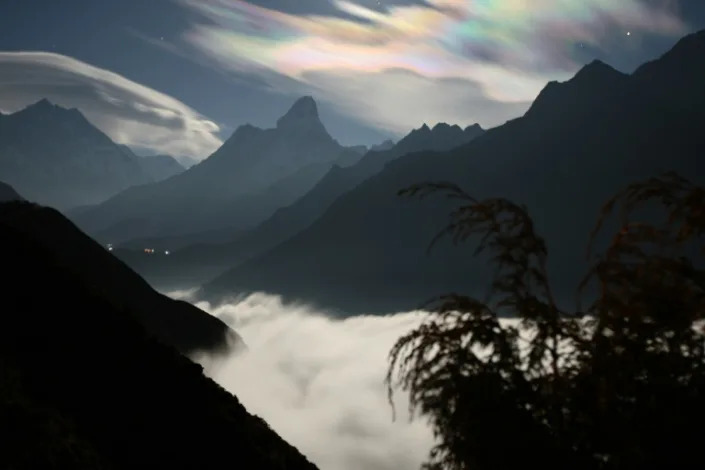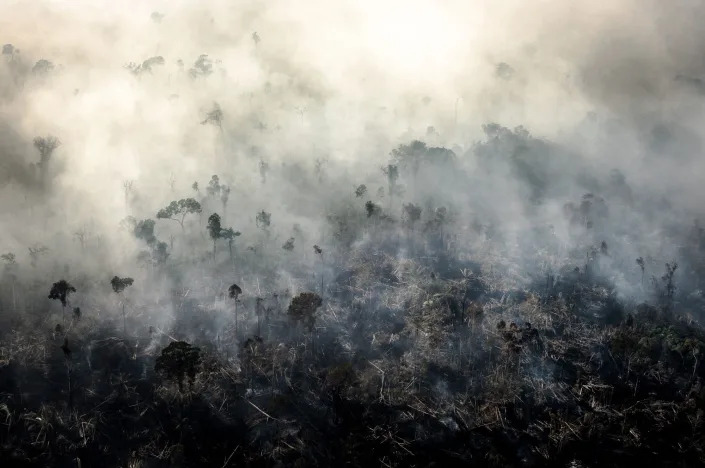Kelly MACNAMARA
Thu, January 26, 2023

Climate extremes in the Amazon rainforest are directly affecting those in the Tibetan Plateau, scientists said Thursday, warning that the Himalayan region crucial for the water security of millions was close to a potentially disastrous "tipping point".
Planet-heating pollution from human activities is raising global temperatures and scientists have said this is pushing crucial ecosystems and whole regions towards often irreversible changes.
Vulnerable areas include melting polar ice sheets that could cause metres of sea-level rise, as well as the Amazon basin, where tropical forests are at risk of turning into savannah.
But can one tipping point have a domino effect on another region? Recent research suggests this is already happening.
Climate-driven changes in the Amazon basin have knock-on effects on the Tibetan Plateau 20,000 kilometres (12,500 miles) away, scientists in China, Europe and Israel reported in Nature Climate Change earlier this month.
"We've been surprised to see how strongly climate extremes in the Amazon are connected to climate extremes in Tibet," said co-author Jurgen Kurths from Potsdam Institute for Climate Impact Research.
The researchers used global near-surface temperature data over the last 40 years to map out a pathway of climate links. They stretched from South America to Southern Africa, on to the Middle East and finally into the Tibetan Plateau.
In their study, the researchers then used computer simulations to track how global warming might change these long-distance link-ups out to 2100.
They found that when it gets warmer in the Amazon, temperatures also rise in Tibet. But when rain increases in the South American rainforest, snowfall decreases in the Himalayan region, sometimes called the "third pole".
- 'Tipping cascades' -
Using snow cover data, the scientists also detected what they say are early warnings the Tibetan Plateau has been approaching a tipping point of its own since 2008.
The Tibetan Plateau supplies a substantial proportion of the water needs of almost two billion people across South Asia, Southeast Asia and China.
Research published in Nature Climate Change last year said climate change could deplete terrestrial water storage over the Tibetan Plateau, which may ultimately threaten water availability downstream.
Other studies have shown a warming trend in recent decades in the region which -- like the Arctic region -- is warming two to three times faster than the global average.
But Kurths said the proximity to a potential point-of-no-return transition had been "overlooked so far".
The researchers said that while their study suggests a heightened risk of "tipping cascades" it was unlikely that the climate system as a whole would flip into a new state.
"Yet, over time, sub-continental tipping events can severely affect entire societies and threaten important parts of the biosphere," said co-author Hans Joachim Schellnhuber from PIK.
"This is a risk we should rather avoid."
To avoid the worst impacts of warming, countries have agreed to keep temperatures from rising above the limit of well below two degrees Celsius since the mid-1900s, and preferably below 1.5C.
For that to be achieved, planet-heating greenhouse gas emissions, mainly from fossil fuels, must decline some 45 percent compared to 2020 levels by the end of this decade, and to net zero by mid-century, according to the UN's climate science advisory body.
klm/mh/jj

Carly Wanna
Thu, January 26, 2023
(Bloomberg) -- Two new scientific review articles by international teams of researchers paint a bleak picture of the state of the Amazon rainforest: The critical ecosystem is being damaged at an unprecedented pace, they warn, which may usher in “a qualitatively different global climate regime” with grievous effects on biodiversity and human welfare.
The papers, both published in the peer-reviewed journal Science on Thursday, summarize research on deforestation and landscape degradation in the Amazon to deliver a sharp message. The region that is key to the world’s climate system “is now perched to transition rapidly from a largely forested to a nonforested landscape,” write one set of authors, “and the changes are happening much too rapidly for Amazonian species, peoples, and ecosystems to respond adaptively.”
The main culprits are human activities, such as logging and clearing forest for cattle pasture, as well as climate change.
“We know the two major drivers of deforestation are global climate change and regional deforestation,” said James Albert, a biologist at the University of Louisiana at Lafayette and lead author of one of the articles. “If you allow development to proceed unregulated, you will have an ecological disaster.”
Albert and his team analyzed data from the Science Panel for the Amazon Assessment Report, which documents changes to the Amazon’s ecosystem and biodiversity. Specifically, they compared how fast humans are changing the Amazon with the speed at which other natural processes are affecting it. They found that human factors are causing degradation and habitat destruction at a rate hundreds to thousands of times faster than natural phenomena are.
Already, 17% of the rainforest has been impacted by disturbances like logging, fires and road expansion, and 14% of it has been replaced with pasture or cropland.
The second review focuses on other human-caused factors that degrade the Amazon — including timber extraction, fire and extreme drought. By analyzing existing data, the researchers found that these impacts are degrading roughly 2.5 million square kilometers (965,000 square miles), representing more than one third of the region’s remaining forest.
According to lead author David Lapola, a research scientist at University of Campinas in Brazil, the analysis rounds out the focus on deforestation that characterizes much other Amazon research. “Even though we’ve been looking to the Amazon for quite some time with our scientific glasses, there are many processes directly caused by man that we’ve been ignoring,” Lapola said.
The researchers call for proactive measures to conserve the Amazon and broadly reduce global emissions, such as stronger forest-protection policies and a halt to international financing of market-driven land conversion. Brazil’s recently elected president, Luiz Inácio Lula da Silva, has pledged to safeguard the Amazon after damage to the rainforest accelerated under his predecessor, Jair Bolsonaro.
William Ripple, an ecologist at Oregon State University who did not co-author either article, said the reviews do “an outstanding job” documenting the Amazon in crisis: “This is an example of the toll humans are making on ecosystems all over the world, and at some point we will need to change our ways to survive.”
Amazon heat drives Tibet temperatures: climate tipping elements connected half around the globe
While the Amazon rainforest and the Tibetan Plateau sit on different sides of the globe, scientists now discovered that changes in the South American ecosystem can trigger changes in the vicinity of the Himalayas
Peer-Reviewed Publication“Logging, road construction and warming are already today stressing the Amazon rainforest, and will likely do so even more in the future – and while the Amazon region is of course an important Earth system element by itself, it’s also a burning question if and how changes in that region could affect other parts of the world,” explains Jingfang Fan from Beijing Normal University, China, and the Potsdam Institute for Climate Impact Research (PIK) in Germany. “For the first time, we’ve now been able to robustly identify and quantify these so called teleconnections. Our research confirms that Earth system tipping elements are indeed inter-linked even over long distances, and the Amazon is one key example how this could play out.”
Analysis of air temperature changes in 65.000 subregions in the past 40 years
The researchers analyzed near-surface air temperature changes in a grid of more than 65.000 subregions, regarded as nodes, they put on the globe, using data from the past 40 years. By doing so, they could see how changes at one node influenced those at another one. They succeeded to detect a pronounced propagation pathway over more than 20.000 kilometers – from South America via Southern Africa to the Middle East and finally to the Tibetan Plateau. This pathway can be explained by the main atmospheric and oceanic circulation patterns.
In a next step, the researchers used state-of-the-art climate computer simulations to see how global warming, caused by greenhouse gas emissions from burning fossil fuels, might modify the long-distance linkages until 2100. “We’ve been surprised to see how strongly climate extremes in the Amazon are connected to climate extremes in Tibet,” says Jürgen Kurths from PIK, a co-author of the paper. “When it’s getting warmer in the Amazon, it also does so in Tibet, hence for temperature there’s a positive correlation. It’s different for precipitation. When we have more rain in the Amazon, there’s less snowfall in Tibet.”
The researchers detected the early warning signals based on the snow cover data and reveal that the Tibetan Plateau has been losing stability and approaching a tipping point since 2008. “This has been overlooked so far,” says Kurths. Despite its remote location, the Tibetan Plateau is relevant for a lot of people’s livelihoods due to its role as an important water reservoir.
"This is a risk we should rather avoid"
“Our research underlines that tipping cascades are a risk to be taken seriously: inter-linked tipping elements in the Earth system can trigger each other, with potentially severe consequences,” says Hans Joachim Schellnhuber from PIK, also a co-author. “To be clear, it’s unlikely that the climate system as a whole will tip. Yet, over time, sub-continental tipping events can severely affect entire societies and threaten important parts of the biosphere. This is a risk we should rather avoid. And we can do so by rapidly reducing greenhouse gas emissions and by developing nature-based solutions for removing CO2 from the atmosphere.”
Article: Teng Liu, Dean Chen, Lan Yang, Jun Meng, Zanchenling Wang, Josef Ludescher, Jingfang Fan, Saini Yang, Deliang Chen, Jürgen Kurths, Xiaosong Chen, Shlomo Havlin, Hans Joachim Schellnhuber (2023): Teleconnections among tipping elements in the Earth system. Nature Climate Change [DOI:10.1038/s41558-022-01558-4]
Link to the article: https://www.nature.com/articles/s41558-022-01558-4
JOURNAL
Nature Climate Change
METHOD OF RESEARCH
Computational simulation/modeling
SUBJECT OF RESEARCH
Not applicable
ARTICLE TITLE
Teleconnections among tipping elements in the Earth system.
No comments:
Post a Comment